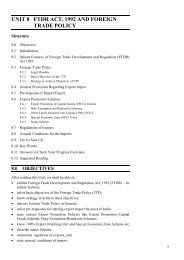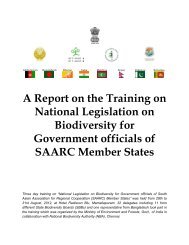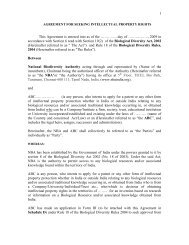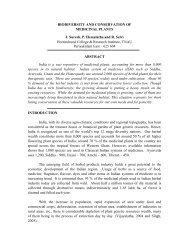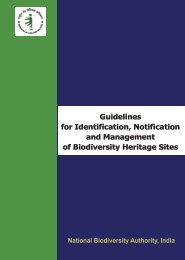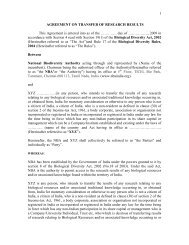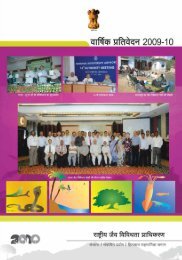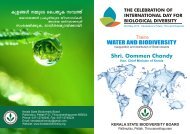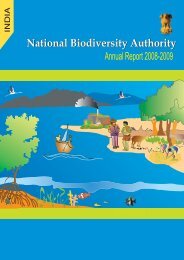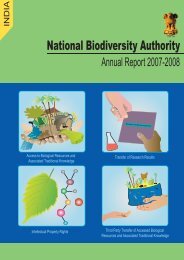BCIL BOOK.pmd - National Biodiversity Authority
BCIL BOOK.pmd - National Biodiversity Authority
BCIL BOOK.pmd - National Biodiversity Authority
You also want an ePaper? Increase the reach of your titles
YUMPU automatically turns print PDFs into web optimized ePapers that Google loves.
NATIONAL BIODIVERSITY ACTION PLAN<br />
3.2 Declining natural resource base and overexploitation<br />
of resources<br />
India is endowed with diverse forest types ranging<br />
from the tropical wet evergreen forests in North-East<br />
to the tropical thorn forests in the Central and Western<br />
India. The forests of the country can be classified<br />
into five major groups based on climatic factors. These<br />
major groups have been divided into 16 forest types<br />
based on temperature. They are further divided into<br />
202 sub-groups and type groups based on location<br />
specific climatic factors and plant species constitution.<br />
Forests face threats on account of diversion of forest<br />
land for agriculture, industry, human settlements, and<br />
other developmental projects. Construction of roads<br />
and canals, quarrying, shifting cultivation and<br />
encroachments are other threats. Degradation of<br />
forests results from illicit felling, excess removal of<br />
forest products, fodder, fuel wood, forest floor litter,<br />
overgrazing and forest fires. As a result, some of the<br />
floristic and faunal components, including many<br />
keystone and endemic forest species are now left with<br />
narrow eroding populations which need to be urgently<br />
conserved.<br />
Even though forestry is the second largest land<br />
use in India after agriculture, covering approximately<br />
23.57 percent (recorded forest area) of the total<br />
geographical area, the contribution to the Gross<br />
Domestic Product from forestry is minimal (it was<br />
barely 1.1 percent in 2001). An estimated 41 percent<br />
of the country’s forest cover has been degraded to<br />
some degree. As much as 78 percent of forest area is<br />
subject to heavy grazing and about 50 percent of the<br />
forest area is prone to forest fires. Domestic demand<br />
for timber and fuelwood is well above the sustainable<br />
level.<br />
The rich diversity of medicinal plants (over 6,500<br />
species) in the country needs conservation and<br />
sustainable utilization, as their habitats are either<br />
degraded or the species are being over-exploited. In<br />
fact, nearly 90% of the medicinal plants in trade are<br />
harvested from the wild. The medicinal plants<br />
constitute critical resource for health care of rural<br />
communities and for the growth of Indian herbal<br />
industry. Currently, India’s share in the complementary<br />
medicine related global market is only 0.3% and there<br />
exists immense scope for expanding its share in the<br />
62 billion US$ world market from the present level<br />
of Rs. 5,000 crores (approximately 1.2 billion US$).<br />
But, it is a sad reflection that while it has the<br />
knowledge, skills and resources, India has not yet<br />
seized opportunities in the global market. Even its<br />
0.3% share is largely (70%) through export of raw<br />
materials and only in a limited way (30%) through value<br />
addition and sale of finished products. Indian exports<br />
are thus guided by what may be termed as a trader’s<br />
vision rather than by a knowledge-products vision.<br />
The MoEF has mooted a Multi-Stakeholder<br />
Partnership (MSP) framework involving the three<br />
partners, namely, the land owning agency/ forest<br />
department, the local village community and the<br />
sponsor, for afforestation on degraded forest lands<br />
and other lands, as one of the measures to achieve<br />
the <strong>National</strong> Forest Policy goal of one-third forest<br />
and tree cover in the country.<br />
Unsustainable exploitation of biodiversity<br />
resources, particularly by developed countries, have<br />
serious adverse impacts, both local and global. The<br />
global impacts are largely manifest in developing<br />
countries, and may further accentuate poverty in these<br />
countries. Failure on the part of developed countries<br />
to provide incentives for conservation in the form of<br />
financial resources, technology transfer and scientific<br />
cooperation, as envisaged under the CBD, further<br />
dampen the conservation efforts in the developing<br />
countries.<br />
12



